Von Collins is an accomplished triathlete and endurance cyclist, and the author of four fitness and training books: Smarter Running, Your First Triathlon Guide, Fit Foods, and 30 Rut-Busting Workouts. He has been cited as a triathlon, cycling, and fitness expert by Healthline, CNET, Forbes, Eat This, Not That and other major outlets.
We love seeing people get into cycling – whether it is purely recreational, or to build up to longer rides, or to ultimately compete in a bike race or triathlon. Our attitude is that the more cyclists there are — regardless of your budget — the more demand for trails, dedicated bike lanes, and bike amenities which we all benefit from. It creates a productive cycle – not to mention, it can make the population healthier which is good for all of us.
Buying an entry-level bike, though, can be mind-boggling. Not only do you have dozens of brands to choose from, but each model seems to have an unlimited combination of components. No doubt, when you start looking for a bike, you will either fall in love with the first one you see, or be numbed by all the choices and decisions you can make.
What’s more, for many manufacturers nowadays, “entry level” can mean anything up to about $2,500. That might give some sticker shocker — it is a bit more than the typical newbie might consider to be entry level, but if you plan to ride a lot, you don’t want to skimp either. Luckily, there are still some pretty good options in the $1,000 to $2,000 range, too, and even a couple in the sub-$1,000 range.
A Note About Road Bike Buying
Before we get into the entry-level road bikes that we really like, we wanted to make a couple comments on the process of buying a bike. We might be a triathlon blog, but at any tri club or on race morning of a triathlon, you will see lots and lots of road bikes. They are part of our sport so we know a thing or two about buying them.
First, there is a reason that Independent Bike Dealers have been a mainstay of the cycling community for so many years. If you aren’t quite sure what you are looking for, and even if you are, they can be incredibly helpful in finding a bike that works for you. Sure, we can make a buck or two if you buy through one of our partners (linked below), but in the bigger picture we want people to ride the right bike for them. If that means a trip to your local bike shop, we are all for it. Our website has never been intended to take business away from local bike shops. Just the opposite — we want to get more people into the sport so that independent bike dealers have a larger universe of customers!
Fred Clements of the National Bike Dealers Association says it best, “a good bike mechanic is an artisan, not a laborer or engineer.” Find a good mechanic at a local shop, and he or she will get you on the right bike for you.
Second, the decision that you really need to make is threefold when it comes to buying a road bike. Which bike frame/make do you want (and this should largely be based on fit), which “moving component” set to do want, and then which bells and whistles are you looking for. This is why you might see one bike model that comes in 20 different variations – there could be an almost endless number of component combinations you can outfit a single bike with.
Third, we list some bikes here that eclipse the $2,000 mark – which might seem like it is way above entry level. We do this for a couple reasons – first, for the right cyclist, $2,000 is a bargain for a good road bike. If you are someone who ultimately gets hooked and puts 5,000 miles a year on your bike, you will want something with some quality and features. Finally, bikes are often discounted by various retailers – so a $2,000 bike might be found for way less if you can catch it at the right time.
5 Great Entry Level Road Bikes
Let’s just get to the point. Here are 5 “entry-level’ road bikes that we really like right now and are easier on the budget (if you were looking for triathlon bikes, don’t worry, we researched that as well, here).
(Cutting to the Chase, our Favorite is…..)
If you want to spare the reading, we will help you get to the point. We assessed these bikes, rode them, inspected them. There are two that stand out. The Cannondale Topstone is a great overall value on a versatile bike, and riding the smooth aluminum frame is a dream. And you gotta love the Trek Domane, especially when it gets the hand-me-down features from its more decked-out Trek siblings.
With that said, let’s outline the top 5.
Bike | Why We Like It | Best For | Price Check | |
Cannondale Topstone | 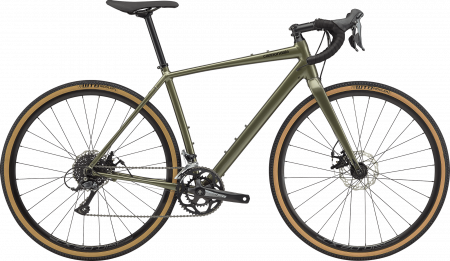 | Gravel-ready bike with trusted parts | Riders who may enounter all surfaces. | |
Salsa Journeyer Claris |  | Can't beat the price; gravel-ready on sturdy road bike | Entry-level, shorter rides | |
Felt VR40 | 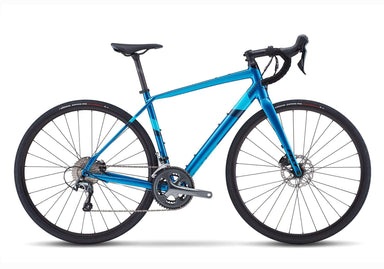 | Felt brand; Comfortable on long routes. | Longer rides, touring, group rides | |
Salsa Journeyer Apex |  | A lighter, funner-riding version of the Journeyer Claris. | Someone who wants a gravel-ready road bike with mid-range SRAM components. | |
Trek Domane |  | Unlimited design and groupset options. | Riders who might do some advanced, longer riding. |
Cannondale Topstone Road Bike
The Cannondale company has been building bikes since 1971. While many bike companies tend to be based in the Northwoods of Wisconsin or Minnesota and Western USA, Cannondale is an East Coast company, based in Connecticut. We like the lineup that Cannondale offers, although they crank out enough bike models so it can take some time to get your head around it all.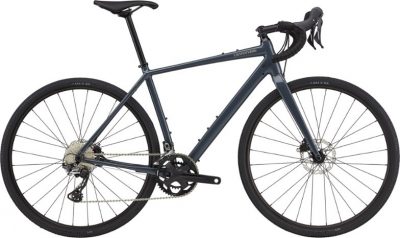
The Topstone is actually a pretty massive lineup of bikes — positioned just under the Synapse lineup which has become a little too pricey to be “entry level” in our book. Some Topstone models can be found at the entry-level price point, and depending on componentry will typically be found for $1,000 to $2,000. That is a good price for a very high-quality bike. Other models can cost double that price or more. We are obviously focused on the entry-level price point for this article, so are talking about the alloy frame. The one that we recommend is the Topstone 1, a great alloy bike that gives you an excellent ride on both fast pavement and hardpack gravel (it is actually also on our list of best gravel bikes for this reason), and is even a good commuter bike — an excellent all-around model. If you want to spend just a little more, there is the Synapse 105, coming with (as you could guess) Shimano 105 componentry. There are some great Synapse models well above the $2,000 price point, but we can’t in good faith say they are entry-level bikes. The Synapse 105 sometimes fits the entry-level bill, though, depending on where you find it.
One of the first things I noticed when testing out a Topstone was that its gearing is a little lower and slower, which is great if you plan to ride places with lots of twists, turns, and climbs. But if you really want to crank fast on a long straightaway, you might find the top-end of your speed range a little wanting — but not by much. The big and small chainrings have 46 and 30 teeth respectively, compared to 50/34 for many on this list or 53/39 which is a classic, common combination for old-school road bikes.
I liked that all of the Topstone models now come with disc brakes, regardless of if you buy the high-end or the low-end model. They all have a carbon fork as well, which corners better than alloy and is a little more forgiving overall.
Because of the number of variations on the Topstone, it isn’t hard to modify or upgrade certain components while staying within the Cannondale brand and with a Cannondale dealer. The bike shop where I did my Cannondale exam had many of the parts in stock, behind the counter, from previous mods and builds.
What we like about the Topstone:
- Cannondale sleek alloy frameset. With the combination of frame and components, this is a bike that you couldn’t have gotten for the price 4 years ago. Note that the Synapse also comes in an aluminum frame if you can find it. We think both are worth considering.
- Micro-suspension built-in to rear stays. Allows for some shock absorption through the frame.
- We love that Carbondale is putting disc brakes on virtually everything they build, regardless of price.
- Carbon fork will give you better cornering
- Fabric scoop radius saddle, a comfortable saddle for riders of all skill levels. Scoops are some of our favorite road bike saddles.
- Slightly more upright frame geometry, which is the better choice for people who are not time-trialing. Overall, this is a balanced frame that allows you to do fast road rides without being in an uncomfortable drop position — something that might not be second nature for beginners.
- Generally speaking, Cannondale seems to try harder than some of the other brands when it comes to creating an approachable and affordable first bike for new cyclists. The Topstone lineup is a perfect example of that.
- Cannondale is one of REI’s carried brands, making brand-customized service accessible if you live near a major metro
Find the Topstone and the Synapse here.
Salsa Journeyer – Claris
If your goal is to truly get on the ride while keeping your overall spend down, take a good hard look at the Salsa Journeyer. Like the Topstone, it is a bike that is suited for both road and gravel.

We find the Journeyer to be a solid choice for anyone looking to dip their toes into gravel riding or bikepacking for the first time, and wanting to do it with a new bike. It handles well on a variety of terrain, and the geometry strikes a good balance between comfort and control. That said, it’s not the fastest or lightest bike out there, so if you’re chasing performance and PRs on Strava segments, you might find it a bit sluggish, especially on climbs. The wide tire clearance and mounting options are a definite plus for for bikepackers or those looking to do some rugged gravel riding. The stock components can feel pretty standard, and you may want to upgrade if you’re planning on serious long-distance rides. Overall, it’s a capable, versatile bike, and one that comes at a very reasonable price.
The Journeyer (for which we did a more thorough review, here) can come in at the sub-$1,000 price point for a couple reasons. First, it has the Claris components, which is the entry-level from Shimano in the road category. If you love the bike, you can always upgrade later to the Tiagra or 105 groupset. Second, the Journeyer uses an aluminum frame. Not a bad thing, especially on gravel, but for pure road riders the aluminum frame will give you a little extra rolling weight. It runs a few pounds heavier than a bike that would be at the $2,000+ price point. With that said, our rides on the Journeyer have been snappy enough to be very enjoyable.
If what you are looking for is a basic bike from a reputable manufacturer, this price is hard to beat.
What we like about the Salsa Journeyer:
- A good solid aluminum-framed bike from a manufacturer – Salsa – we really trust
- Gravel-ready. While this bike is a road bike, it is extremely amenable to doing a road-to-gravel conversion if you want
- Ability to mount up to 38mm tires.
- Internal cable routing throughout the alloy frame – this is something normally found on higher-end bikes.
- Disc brakes, something you definitely want in this day and age even if you are going with an entry-level bike
Felt VR 40 Road Bike
We have been riding Felt bikes of some sort for decades. Literally. Why? They have somehow figured out a way to combine quality frames, step-up components, and a reasonable price point. If someone held a gun to our head and said we needed to pick a bike brand, site-unseen, for a long ride, we would probably just choose a Felt — that is how much we like them.
On the paved trail, I found that the VR40 does not disappoint, and gives you the upgraded, zippy ride experience that we would expect from a Felt. In the same lineup, the VR 40’s less-expensive sibling, the VR 60, is a great option if you are under a tight budget and it actually has the same frame as the VR40.
Why then do we recommend the VR 40 for $450 more? One word: Tiagra. The VR 40’s Shimano Tiagra components are a nice upgrade over the VR 60’s Claris components. We have nothing against the Claris line, but the Tiagra is a decided step above if you are seriously getting in to road cycling.
The Felt’s aluminum frame is relatively light and rides smooth. You might be tempted to insist on carbon fiber, but going for a carbon frame in the VR lineup means that you are going to shell out about $1,500 more. Yep, almost two thousand more to get the carbon frame.. By going with the aluminum frame, the VR40 will let you get much better components for the money. You could save yourself about 2 pounds, or you could get shifters that are going to be smooth, and gearing that will let you get-up-and-go.
My test-drive was impressive. We found that the bike felt lighter than its real weight, accelerated very well, and we energetic when going up hills. When it comes to bang for the buck, I’m not sure you can beat it. As I examined all the components in detail, I concluded that this was a bike you could ride as-is for a long time without doing any upgrades.
What We Like about the VR 40:
- Excellent aluminum frame that is capable of great road riding, but also gravel-worthy if needed. Frame is light as far as aluminums go.
- Dual-piston disc brakes give you plenty of clearance if you want to run slightly wider tires. Max clearance on tires goes up to 34mm, and while that is not enough to run true gravel tires, you can have a pretty all-purpose tire at that width (it comes stock with 30s)
- We love the Devox bars, comfortable in both bullhorn and drop position. These are the same bars you would get on the much more expensive Felt models.
- Given the smooth ride, we have no qualms about this aluminum frame and think this bike is a great value for the money.
Overall, an outstanding bike for the money, and a bike worthy of customizing to suit your riding style. If you need to save a few bucks, you can consider the VR 60 and then gradually upgrade your components, but we think it is best to just start with the VR 40.
Salsa Journeyer – Apex
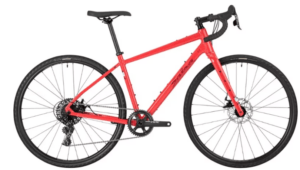 Up above, I talked about the Salsa Journeyer in the Claris components, which are really the rock-bottom of the Shimano options. There is nothing wrong with riding Claris, especially if you are truly entry-level, but some riders will want a bit of an upgrade. That’s where the Apex model comes in, at a price point in the $1,500 range but will an ability to be a swifter and easier-to-ride bike.
Up above, I talked about the Salsa Journeyer in the Claris components, which are really the rock-bottom of the Shimano options. There is nothing wrong with riding Claris, especially if you are truly entry-level, but some riders will want a bit of an upgrade. That’s where the Apex model comes in, at a price point in the $1,500 range but will an ability to be a swifter and easier-to-ride bike.
I gave the Salsa Journeyer Apex a nice ride on both pavement and gravel roads, and really liked what I experienced. Using 30mm tires — slightly thicker than your typical road tire or slightly thinner than your normal gravel tire — it had plenty of acceleration at the start and was responsive on the winding road. The Journeyer was LOTS of fun to ride on the open straightaways where you are trying to rip out a fast segment on Strava.
Some riders might balk at the aluminum frame for this price range, but at this price point you are not going to get high-grade carbon anyway, so going with aluminum is just fine. Granted, the 22 to 23 pound weight range might be a couple pounds higher than you will find in some other entry-level road bikes, but those road bikes won’t give you as capable an option of using the exact same bike on gravel when needed. I guess if you are going to use this bike for road races, you might opt for something a little lighter.
Still, this bike is a couple pounds lighter than the base-level Journeyer Claris.
I haven’t talked about the SRAM Apex groupset – a great groupset for the money. That SRAM can crank out components like this at a reasonable price is really a value for riders. You are going to have a crank, shifters, derailleur, and brake levers all from this strong groupset. By the way, while I recommend the Apex for the money, you can save a few more bucks by choosing the Sora groupset which sits in between the Apex and the Claris.
Our test rides confirm that this aluminum frame will ride well (and once again. For the same price, you are going to get high-end aluminum or quite low-end carbon. We loved the acceleration from a standing stop and on hills, and enjoying the handling when winding downhill and around curves. When paired with the right road tires, you are going to get plenty of speed from the Journeyer.
What we like about the Salsa Journeyer Apex Road Bike:
- Strong frame that fits lots of builds
- Ideal for those who might find themselves on gravel at times
- Ability to accommodate tires up to 38mm, a good, average width for a variety of conditions
- SRAM Apex groupset – an outstanding value
All-in-all, we are big fans of the Journeyer Apex, and think it is probably worth the additional money vs. the Claris version.
Find the Salsa Journeyer Apex Here
Trek Domane 4 Road Bike
It is hard to have a “Best of” list without including something from Trek. After all, Trek was one of the companies that really brought entry-level road bikes to the masses as the sport grew in the early 2000s. While Trek is known for its broad array of bikes – mountain, triathlon, comfort – they have a solid road bike lineup, and the Domane is the dominant model right now.

Now, you might think we are crazy for recommending the Emonda, because it is a very deep product line and some decked-out Domanes can hover around the $10,000 mark. The Emonda lineup is very extensive, though, and at last count Trek was offering many different versions of the Domane. But the entry-level Domane choice is the one that we would recommend from Trek, at this price point.
Trek, the Wisconsin-based maker of bikes and other cycling gear – was founded in the 70s. It came of age at the same time as Cannondale, as the American bike scene was growing. Trek has been effective at getting the price point on their entry level bikes quite low – but we recommend spending just a little more than the base level at Trek. Getting on to an Domane will give you payoffs as you grow into the sport.
The Domane 4 is the bike we are focusing on here. It is a comparable price point to the Felt FR, just above, and like the Felt is an aluminum frame. The quality of the frame, based on our test rides, is excellent, and the 105 componentry throughout the drivetrain puts it on par with many of the bikes listed in this article. Behind Trek, you get thousands of riders who swear by the brand, and a broad network of bike shops who will be familiar with working on the bike.
A road test showed me a nice bike that just might be a better fit for taller riders with a longer torso. The aluminum frame was not clunky and about as lightweight as I had hoped, and of course using aluminum allows for the 105 components which I just love. Easy shifting and smoother climbs and acceleration.
If you are willing to spend just a bit more on a Trek, the Emonda is the next step up and a little lighter, and it comes with higher-end stock wheels better, something that can be expensive to upgrade later on. It also has a slightly more aggressive rider posture which is good if you race.
What we like about the Trek Domane:
- Excellent balance and handling overall. Provided you get the right fit, a very responsive aluminum bike.
- Uses the same frame geometry as some of Trek’s higher-end, faster bikes…. So a great choice for those who want speed.
- Disc brakes, which we always prefer if we can get them
- Allows you to get into the Shimano 105 componentry while staying safely under $2,000 overall
What to Look for in a Road Bike
As you could probably tell from our reviews, there are a few things to think about when buying a road bike. It really comes down to personal preference, but you will be faced with decisions on several key things. The big ones, in our opinion include:
- Carbon vs. Alloy (Aluminum) — see the next section
- Components. Cyclist can debate until they are blue in the face about the importance of components, but the fact is that there is a pecking order, and you pay more the higher up you go.
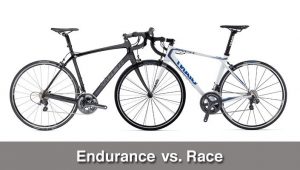
photo credit: Bikeroar.com Most products at the entry-level price point include components from Shimano, but you may also see Bontrager or Campagnolo (Campy) parts. We did an entire piece on their various levels here. For the Shimano examples above, Ultegra is considered a step above 105. Two notes: you can always change components later, and when in doubt, spend your money on the moving components (e.g. chainring instead of brakes). Things like a bike saddle or new pedals are easy to swap out and upgrade at any time, and we find that the “contact points” on the bike — things you will physically be in contact with during your ride like the saddle and bars — are the ideal bike upgrades later because they tend to involve so much personal preference.
It is important to note that bike components are constantly changing and up-leveling, to the benefit of the typical entry-level bike buyer. What was only found on higher-end bikes a few years ago may be commonplace on a lower-priced road bike today.
- Brakes. Speaking of components, you will see entry-level road bikes with both disc and caliper brakes. Disc brakes are considered better, and the trend is toward more bikes moving to disc brakes. 5 years ago, disc brakes were something only found on higher-end bikes. Today, lots of entry-level bikes have them. They offer more clearance from the wheel, work better when wet or on hills, stop faster, and don’t heat up or wear on your rim. With that said, we rode caliper brakes for years and they did their job just fine…. and they are easier for the DIYer to adjust, fine-tune, fix and maintain. Just know that a bike with disc brakes will always cost more than the same bike with caliper brakes. 5 years ago, we would estimate that 75% of entry-level road bikes had caliper brakes as standard equipment. Today, we would say that has nearly flipped, 75% have disc.
- Frame Angle. In addition to frame material, consider the frame angle. Do you want something aggressive, that puts you in a low, aero position? Or something a bit more relaxed (ie. “sportive” or “endurance”) that allows you to be more upright and comfortable?
- Brand. We are not brand snobs here, but it can be good to buy a brand that has a good track record and warranty. The last thing you want is a crack in your carbon frame, and nobody who you can call. This is probably most true when it comes to buying at major online retailers who carry imported, startup brands. The tried-and-true brands (like those listed above) will take good care of you.
- Fit. Don’t ever skimp on fit for your bike. Most people will pretty neatly fall into a bike size, so it is relatively easy. Others are constantly on the borderline between one size and another, making it more difficult. For years, I have been a 58. When I walk into a bike shop, the owner typically looks at me for 3 seconds and says “Your probably a 58, right?” That makes it easy. But the silliest thing I could ever do is buy a 56 just because it was on sale or I liked the model. Buy the size that fits!
- Add-Ons. You likely will buy a bike that is pretty basic — it will be a brand-new, high-functioning bike but the add-ons will be yours to install. Whether you ask a bike shop to do it, or install add-ons yourself, think about things like your hydration setup, a bike computer, and other add-ons that that suit your riding style.
A Word About Carbon vs. Aluminum Bikes
Our lineup of 5 great bikes includes 3 carbon frames and 2 aluminum frames. Aluminum (alloy) frames have enjoyed a bit of a resurgence lately, as makers like Trek and Felt have really cranked down the overall weight and built beautiful, nearly seamless frames. When you are looking at the $2,000 price point, keep in mind that you might be getting a top-of-the-line aluminum frame or a relatively entry-level carbon frame at that price.
Still, carbon is carbon, which we love, and the bikes listed above are made by manufacturers who would not skimp on the build. They just can’t put the same time and material into a $2,000 bike that they would a $5,000 bike. The Salsa Journeyman is a great example of what you can do with aluminum that you would never be able to do at the same price with carbon.
That is our long way of saying don’t shy away from aluminum, especially if the bike might be riding on some less-than-perfect trails. Carbon is awesome, but there are some great bikes being welded in aluminum too. As Cycling Weekly says, there is really no right or wrong frame material, it is all dependent on what kind of riding you plan to do and what you need from your bike.
Should You Buy a Used Road Bike?
Maybe a brand new road bike isn’t in your budget, or isn’t really your speed. Should you buy a used bike instead? Don’t rule it out.
You can, of course, find some pretty solid road bike deals on Craigslist, Ebay, and Facebook marketplace. Each has its own considerations.
Craigslist and Facebook Marketplace both provide buyers with the ability to find bikes in their own backyard. This can be extremely useful if you are someone who wants to buy a bike, say, 5 miles away from you. That allows you to test drive the bike, see it before you buy, and talk to the owner first-hand to get a sense of if they are someone whose bike you want to buy. The downside? Selection will probably be quite limited. Expect to have lots of “perfect bike, wrong size” situations, and expect also to have a few folks thinking their bike is worth 2x what it really is worth.
Another thing to know about bikes is that manufacturers gradually improve the quality of the parts and components at each price point. So the drivetrain that might have been an upgrade 5 years ago might now come as standard on the entry-level model. Keep that in mind as you compare your options.
Ebay will definitely give you more selection, but the obvious issue is that you cannot physically see the bike before you buy it. This poses a problem in two regards: 1) Issues like hairline fractures in the carbon fiber would be very hard to spot on a photo, and 2) returning the bike if something is off is not going to be a simple task.
Perhaps our favorite source for good used bikes right now is Trek’s used bike online store (here.) You can buy directly from Trek, and they have inspected everything to be sure any defects are disclosed.
Either way, if you consider the Craigslist or Ebay routes, insist on a bike that is the right sizing for you, and make sure that the frame and wheels are in very good condition. Everything else can be fixed or replaced.
How Much Does a Road Bike Cost?
When is comes to the budget for your purchase, a road bike is not cheap, and they have gotten more expensive in the past 24 months as supplies and components have increased in price. We actually did another piece addressing one of the most common questions we get — “Why do bikes cost so much?!”
If you find a brand new road bike for less than about $800, there is a good chance it will be disappointing in terms of performance. It is just hard to build a road bike for that price and still have any profit margin left over — and you want the bike maker to make enough money to stay in business.
We think that for a price of about $900 to $2,000, you can find a good road bike that will not only perform will now, but one that you won’t grow out of quickly. That is an important part of all of this — you want the bike to be one that you keep for awhile. You might have a few more entry-level components on the bike, like drivetrain parts, but they can always be upgraded.
From about $2,100 to $3,500 or so, you are going to get an upgraded frame material, and components that are solidly in the quality category. At this price, you should expect that pretty much every part of the bike is middle or getting toward to top of the line, in terms of component options.
Above $3,500, expect a high-quality bike with components that are light, perform very well, and a bike that rides like a dream. At this price, you should not be tempted to upgrade any components any time soon.
You can spend much more on a new bike, but most the people reading this will be in that $800 to $3,500 range.
Our Conclusion and Recommendation for an Entry-Level Road Bike
So you want us to choose one of these bikes? Well, we had to winnow down a list of about 30 good options to get to this list of 5, so consider all of these our choices! Seriously, we would be happy to see you riding on any of them, that is why they made the cut.
If we could only choose one from this list, it would probably be the Trek. With that said, it’s price point is at the high-end of what we consider to be entry-level, so understand if it is a bit out of reach.
For the bikes that are a little more affordable, we really like the value in both the Topstone right now. It is a great bike if you plan to be riding some gravel along with the pavement, and you enjoy a quick bike twists and turns.
Get out there and ride, be safe, and enjoy the sport!








Entry level 1500$? LOL
I know. It is what the world has come to!
what about RGT cycling , and Motobecane titanium ? RGT is free
and the F22 is made of titanium
Where are the giant bikes? The Tcr advanced is a great bike.
You didnt mention steel bikes
I wonder why you did not mention Canyon Endurace at all when it’s such an obvious contender to a quality “entry level” bike, and with outstanding bang for the buck (same level as Emonda and Synapse, but cheaper). But I’m biased, of course: I own one. Love it.
When you talk about entry level I thought you meant about TREK 1.2, and so.
Bykes for less than $1k
I started 5 years ago riding 10-15 kms, after 6 month more than 60 kms and after a year more than 100 kms on a single ride on my 1.2.
I did that for more than 3 years making even more than 150 kms each ride and nobody really understood that my bike was an entry level model.
After that I moved to a Trek Domane 4.3 continuing my rides 2-3 times a week for 1.5 hours each, and for long rides once a month.
I’m sorry, but my Schwinn (yes Schwinn) Phocus 1600 for $450 is ENTRY level. Aluminum frame, carbon fork, shifters integrated into the breaks, and Shimano Clair’s gear set. Sure, there are some corners cut, but that’s entry level. $1500 as entry level is a total joke.
Remember, trek, felt ,canondale and cervelo are known on the biking industry. The rest just followed
Thank,s For Sharing This article about road bikes.
Where’s schwinn?
If these are entry level which one are advanced level. Not everyone is rich sitting on dads money.
Super helpful and informative
The picture/description/price above don’t resemble the Cervelo P2, did you mean the C2? It looks like the C2 has been phased out, is the Caledonia 105 comparable/recommended?
Thanks Scott. We might have left an old picture up there, the C2 was a favorite of ours for years. We will take a look right now!
Only Aluminum and Carbon Fiber? Did the bike gods forget about Steel (chrome-moly) I have a 1980 Trek with Reynolds 531 tubing that still gets ridden regularly. Even with it’s antique components, including a Brooks Saddle, I would not trade it for anything on this list.
When your traveling on the middle of no where, it is a lot easier to find a welder to mend a cracked steel tube than find someone who can repair a carbon fiber tube.
Also, no mention of Giant Bicycles? Well actually you may have. Most of the bikes on this list are manufactured by Giant.
Love this article specially the points between Carbon vs. Aluminum.
It helps to choose the right bike for my younger brother. Taking everything into consideration, I think the Aluminum frame is the best choice.
Can please give me some suggestions on the Aluminum bike for purchase?
Huh fugi anybody middle of the price spectrum and specs good all-rounder see sportif
1.1
Only Aluminum and Carbon Fiber? Did the bike gods forget about Steel (chrome-moly) I have a 1980 Trek with Reynolds 531 tubing that still gets ridden regularly. Even with it’s antique components, including a Brooks Saddle, I would not trade it for anything on this list.
When your traveling on the middle of no where, it is a lot easier to find a welder to mend a cracked steel tube than find someone who can repair a carbon fiber tube.
Also, no mention of Giant Bicycles? Well actually you may have. Most of the bikes on this list are manufactured by Giant.
I am a 60 year old woman and I’m just about to start cycling for the first time can anyone reccomend a bike for me it will be country winding roads need a light bike .. also not so expensive .thank you
Wasn’t there an REI Co-Op bike on this list recently?
Great article regardless of supposed “Entry Level” pricing. Seems these days everything you read from cycling is about machines from $3000 + to $12,000 + models so KUDO’s. It was nice to see that what I chose; the ORBEA AVANT H40 because the Tektro mech brakes are good enough for desert flat riding, threaded BB, integrated C.P., lifetime warranty, and GEO made the list. Can’t wait to hop on it for some long rides since that’s what I generally go for. Bikes got to be delivered first?
Hi there and thank you for the great article. I want to ask, as I saw Felts FR30 on your list of TOP 5, but I do not see its review in the article?
Many thanks